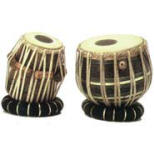| |
HISTORY

If we observe nature we see that
every phenomena is rhythmical: sun rising, planet orbitting and
tide flow. Every growing phenomena is regular. On the other side,
internal life of man is arrhythmical nowadays: feelings and emotions
go one after another without stopping being irregular in their
duration. Itís a real mess.
Evidence of table uses has been found at temples from the year 500
BC where two hands beating a table are drawn. This instrument has
evolved as centuries went by. It is used in India and other Asian
countries and produces a cautivating rhythm. It can be executed
alone which includes great ability, or it can be played as a support
instrument.
It consists in two table drums with wooden body and a patch made of
goat leather with a paste in its center made of integral flour and
iron smelting dreg which causes that particular sound and itís stick
by a lace also made of goat leather and finished by wooden pieces
that are put between the lace and the helmet. The other drum is
called bayan. It is circular, has a patch and tension system similar
to the other one. The main characteristic is its low sound effect
obtained by sliding your hand on the leather.
The tabla and bayan are played simultaneously by both hands in a
strict rhythm model. The rhythm models of the table are formed
producing a mixture of sounds (bol) playing various parts of the
instrument which produces periodic beatings.
A beat is a cycled-limited time repetition from combined beatings of
individual sounds. The sound is produced as a direct result from the
hands and fingers impact on the various components of the divisions
of the drums group. The individual bol (the sounds) is the matra
elector. When the series are executed cyclical they produce the
rhythm and are responsible to set the time. The cyclic reproduction
of these bols composes a taal. A taal is a fixed number of matras
and it is repeated. Variations of bols can be done, they can be put
on the taals and they are called tukras, etc of the kaida. The time
can be classified in three spades: Velocity :1) the vilambit (the
slow time),2) the madhyam (the middle time) and the drut (the fast
time). The player must have ability to play Indian music because of
these techniques, but itís not important because in Hindu tradition
NADA (sound) is the exact creation process, the instrument is the
mean to reach a state of consciousness.
Methodology:
The study of the Tabla includes:
Different types of sounds
Sitting down ways
Tala: Teental, Dadra, Roopak,Ektal,
Tihail: Dhamdar, Bedamdar, Anaghat
Tihail: Chakradam, Farmashi Chakradam
Kaidas, Tukras, Paltas, Kism, Peskar, Laki, Gat tukra, Mukra ,Param.
|
|

